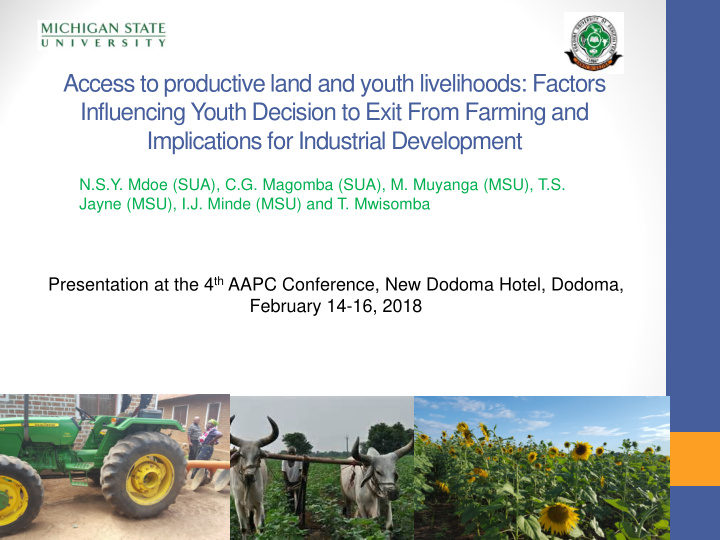



Access to productive land and youth livelihoods: Factors Influencing Youth Decision to Exit From Farming and Implications for Industrial Development N.S.Y. Mdoe (SUA), C.G. Magomba (SUA), M. Muyanga (MSU), T.S. Jayne (MSU), I.J. Minde (MSU) and T. Mwisomba Presentation at the 4 th AAPC Conference, New Dodoma Hotel, Dodoma, February 14-16, 2018
Introduction Youth migration as an alternative livelihood strategy induced by lack of access to productive land in sub- Saharan Africa - strategy - gap always forgotten in research Factors influencing youth’s decision to exit (migrate) from farming: Probit regression model using the 2008/09 to 2012/13 national panel survey data Descriptive statistics based on 1,200 households in 8 districts of Tanzania Mainland 2
The probit regression model • Analysis done at individual household member level involving youth aged 15-35 years • Model Variables: Dependent variable: binary variable =1 if youth aged 15-25 years was faring in 2008 but decided to exit from farming (migrated) in subsequent years Independent (explanatory) variables: - individual youth characteristics - household level factors 3 - community level factors or locational context
Household Level Factors Community Level Factors or Individual Youth Locational Context Characteristics Household head Other household characteristics characteristics Distance from Age homestead to Household age Number of brothers and Sex motorable road sisters to household head Household head Education Distance from Number of male youth sex between 15-30 years homestead to market Household Number of female youth Annual mean education between 15 to 30 years temperature Number of year of Land holding size Annual precipitation household head in Number of livestock Slope Own tractor current residence Population density Own plough Own TV Own cell phone Land productivity Labour productivity Youth Decision 4 Exit from Remain in farming farming
Results of the descriptive analysis • Access to land by youth aged 15 -35 years On average 20% of the sample households reported ownership of land by their children. Ownership varied, 8% in Kilombero district to 30% in Mkuranga district. Inheritance major method of land acquisition among youth, accounting for approximately 56% of the households. Male youth to be favored in land inheritance across all sample districts Purchasing, community allocation and government allocation account for 25%, 8% and 11% of the sample households respectively 5
Results of descriptive analysis (Cont’d) • Youth migration Youth aged 15-35 years account for approximately 71% of the migrants reported of which 57% were female and 43% were male Most (61.6%) migrated to rural areas within and outside their locality Migration to urban areas in the country and outside the country account for 37.8% and 0.6% respectively 6 Reasons for migration
Results of the probit regression analysis • Factors that significantly influence youth’s decision to exit from farming summarized in Table 1. • Key results are: Exit from farming (outmigration) among youth is more prevalent in high densely population areas The probability of youth decision to exit from farming declines with increase in the land holding of parent The higher the net productivity per unit of land the less the probability of youth decision to exit from farming Male youth more likely to exit from farming than female youth if land productivity declines The longer the distance to motorable road as measure of remoteness the higher the probability of youth decision to exit from 7 farming
Results of probit regression analysis for household level factor • Table 1: Factors influencing youth decision to exit from farming Explanatory Variable All Male Female Characteristics of individual youth Age of the youth (years) -0.01*** -0.01*** -0.01** Post-secondary education 0.39*** 0.24 0.47** Household head characteristic Age of household head (years) 0.23*** 0.22*** 0.15** Household head sex (1=male) -0.75 0.03* -0.03* Secondary education of household head -0.01 -0.04* 0.01 Other household characteristics Number of brothers and sisters 0.02** 0.03*** 0.01 to household head Land holding (ha) -0.01** -0.01** -0.01** Land productivity per ha -0.04*** -0.06** -0.03** harvested ('million TZS’) 8 Labour productivity per resident -0.14** -0.14* -0.14 adult ('million TZS’) Number livestock (TLU) 0.35** 0.37** 0.43** Own tractor (1=yes) 0.54** 0.81*** 0.00*** Note: ***, **, *: significant at 1%, 5%, and 10% levels respectively.
Table 1 (Continued) Explanatory Variable All Male Female Community level factors Distance from homestead to motorable road (km) 0.34** -0.02 0.52** Annual precipitation (mm) -0.04* -0.01 -0.05 Population density dummies (base: 0-50 persons/km 2 ): _50-100 -0.01 -0.02 0.03 _100-200 0.02 -0.03 0.02 _200-300 -0.01 -0.03 0.03 _300-500 0.01 0.05* -0.04* _500-1000 0.02 0.07* -0.02 _>1000 0.07** 0.08** 0.07* Note: ***, **, *: significant at 1%, 5%, and 10% levels respectively. 9
Conclusions and Policy Implications • Are you youth decision to exit from farming associated with disliking farming/rural life? They are fundamentally against being poor Their decision influenced by conditions that affect their ability to earn a decent livelihood from farming 10
Policy Implications • Incentives to motivate youth to engage in productive farming • Agricultural policy and strategies to improve productivity in farming and improving market access Improving productivity - increasing access and promoting use of improved technologies including improved seeds, fertilizer, irrigation and other inputs (intensification) - improved farm husbandry practices – extension advice is crucial 11 Improving access to markets- up-scaling the current efforts made by the government to improve feeder roads.
Policy Implications (Cont’d • The above should go hand in hand with promotion of value addition to absorb surplus labor Value addition - is possible with the on-going investments under REA. • The surplus labor released from farming - absorbed in industries other than agro-based industries 12
THANK YOU FOR LISTENING • Sunflower production and processing at Nyamongo village, Tarime District-Tanzania 13
Recommend
More recommend